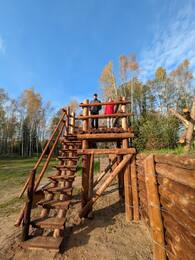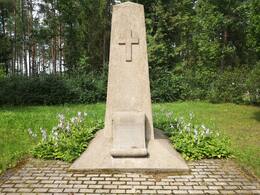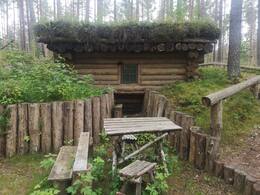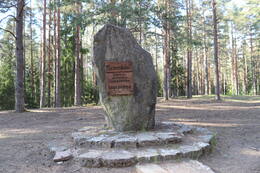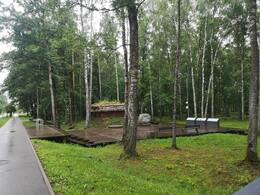Aufbau von Verteidigungspositionen.
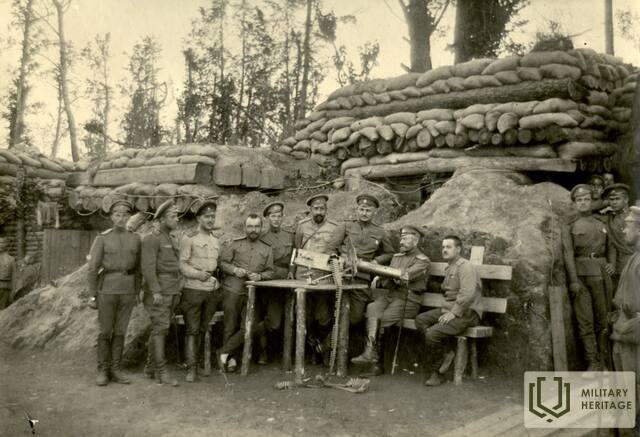
Die Beschreibung untersucht die Probleme der Schlachtfeldbefestigung im Allgemeinen. Sie basiert auf den Erfahrungen des Ersten Weltkriegs und der Situation, in der umfangreiche Arbeiten zur Errichtung von Befestigungsanlagen notwendig waren.
„(…) In Kriegszeiten muss ein Soldat sowohl mit dem Spaten als auch mit dem Gewehr umgehen können. Hat ein Soldat Erfolg erzielt, muss er sich trotz Erschöpfung sofort wieder am Spaten festigen. Im Feldkrieg muss jede Einheit der Armee mit ihren eigenen Kräften Schützengräben ausheben können. Deshalb ist es unerlässlich, die Grundlagen der Befestigung und des Schützengrabenbaus sowie die Arbeitsorganisation genau zu kennen. (…)“
„(…) In allen ausländischen Armeen verfügt jedes Infanterieregiment über Pionier- oder Pionierteams bzw. -kompanien. Um Infanteriepioniere von Pionieren der technischen Truppen zu unterscheiden, werden Infanteriepioniere in manchen Ländern als Pioniere bezeichnet, so wie wir sie auch nennen werden. Die Aufgabe der Pioniere in einem Infanterieregiment besteht darin, Arbeiten auszuführen, die Infanteristen aus verschiedenen Gründen nicht verrichten können, wie beispielsweise das Ausheben von Minenfeldern, einfache Sprengarbeiten, den Bau von Unterständen, die Verstärkung von Kellern, die Herstellung von Tarnnetzen und -farben usw. Darüber hinaus müssen Pionieroffiziere an der Aufklärung der Stellung des Regiments und des Bataillons teilnehmen, ihre Einschätzung abgeben und dem Regiments- oder Bataillonskommandeur den Bau- und Arbeitsplan vorlegen. Pionieroffiziere können auch mit der Überwachung von Befestigungsarbeiten beauftragt werden, ihre Empfehlungen abgeben und das von den Kompanien zu transportierende Werkzeug und Material verteilen. Pionieroffiziere dürfen jedoch die Arbeit der Infanterie nicht behindern. Streitigkeiten werden stets vom Regiments- oder Bataillonskommandeur beigelegt. In allen größeren Ländern verfügt jede Division über …“ Ein Pionierbataillon besteht aus zwei bis drei Pionierkompanien und einem Pionierkorps. In kleineren, weniger wohlhabenden Ländern, die sich nicht viel technisches Gerät leisten können, verfügt jede Division über eine Pionierkompanie und ein Pionierkorps. Pioniere sind in verschiedene Spezialisierungen unterteilt, wie Sprengstoffexperten, Zimmerleute, Minenbauer, Pontonbauer, Tarnspezialisten usw. Sie unterstützen die Infanterie im Kampf durch die Verteidigung befestigter Stellungen, Aufklärung, Überwindung von Hindernissen und Angriffe. Pioniere erhalten ihre Befehle von den Infanteriekommandeuren. Ihnen werden die schwierigsten technischen Aufgaben übertragen, die die Infanterie nicht ausführen kann, wie z. B. das Anlegen von Kolonnenwegen in unwegsamem Gelände, der Bau und die Instandhaltung von Brücken, das Anlegen von Minenfeldern, Sprengarbeiten, das Verlegen von Minenstollen usw. Pioniere führen die benötigten Mengen an Sprengstoff, Material für den Bau von Brücken und Schützengräben sowie Hindernisse für die Installation von Hindernissen mit. In wohlhabenderen Ländern werden bereits in Friedenszeiten faltbare Metallbrücken entwickelt, die schnell errichtet werden können und für schwere Lasten geeignet sind. (..)”
Beschreibung der Technik. Nr. 3. 1927. Befestigung des Schlachtfelds.
Zugehörige Zeitleiste
Zugehörige Objekte
Museum der Weihnachtsschlachten
Das Museum befindet sich im Haus „Mangaļi“ in der Gemeinde Valgunde, Region Jelgava, und ist eine Zweigstelle des lettischen Kriegsmuseums. Es wurde 2005 am Ort der Weihnachtsschlachten des Ersten Weltkriegs eröffnet. An den Schlachtorten sind noch heute einzigartige Befestigungen aus dem Ersten Weltkrieg erhalten. Die Freilichtausstellung des Museums der Weihnachtsschlachten rekonstruiert einen Teil des Befestigungssystems – den Unterstand und einen Teil der ersten deutschen Verteidigungslinie – den „deutschen Wall“, der das einzige Objekt seiner Art im Baltikum ist.
Die Weihnachtsschlachten sind eines der bekanntesten und dramatischsten Ereignisse des Ersten Weltkriegs in Lettland. Sie nehmen einen besonderen Platz in der lettischen Militär-und Kulturgeschichte ein. Sechs Tage lang wurde heftig gekämpft, was zu schweren Verlusten führte. Die Schlachten sind vor allem mit dem Angriff der lettischen Schützen auf die deutsche Armee verbunden, der unter besonders harten und ungünstigen Winterbedingungen stattfand. Dies ist ein beispielloser Fall, in dem eine größere Kampfhandlung ohne Artillerieunterstützung durchgeführt wurde.
Heute beherbergt das Museum Artefakte, die auf den Schlachtfeldern gefunden wurden. Die Innenausstellung ist zu bestimmten Zeiten geöffnet, während die Außenausstellung der Festungsanlagen täglich geöffnet ist. In der Umgebung wurden touristische Routen und Naturlehrpfade angelegt.
Weihnachtsschlachtdenkmal auf dem Brüderfriedhof von Antinu
Im Stadtteil Babīte gelegen, am Straßenrand in der Nähe des ehemaligen Antiņi-Hauses und des alten Medikamentenlagers.
Der Soldatenfriedhof Antiņi oder Tīreļi entstand während des Ersten Weltkriegs. Das Gebiet beherbergte Verteidigungsstellungen der russischen Armee. 1917, während der Weihnachtsschlachten, befanden sich in der Nähe das Hauptquartier des 5. Lettischen Schützenregiments Zemgale sowie ein Lazarett mit Medikamentenlager.
In der Nacht vom 5. auf den 6. Januar 1917 wurden unter dem Schein von acht großen Freudenfeuern 105 Kämpfer des 5. Semgallischen Lettischen Schützenregiments mit militärischen Ehren beigesetzt. Sie waren in Kämpfen gegen die deutsche Armee gefallen oder an ihren Verwundungen gestorben. Die Zeremonie leitete der Regimentskommandeur Jukums Vācietis. Später wurden auch Soldaten anderer Einheiten der russischen Armee auf dem Friedhof beigesetzt. 1925 wurde dort ein Denkmal des Architekten Eižens Laube enthüllt und das Gelände neu gestaltet. Informationen über 3.800 auf dem Friedhof begrabene Soldaten finden sich an vielen Stellen, diese Angabe gilt jedoch als unwahrscheinlich und unbestätigt.
Unterstände und Deckungsgräben der Lettischen Schützen im Tīreļi-Moor
Die Deckungsgräben und Unterstände der lettischen Schützen im Tīreļi-Moor liegen in der Gemeinde Babīte im Landkreis Mārupe, in der Nähe des Schützen-Friedhofs Antiņi und des einstigen Medikamentenlagers. Hier lagen im Ersten Weltkrieg die Abwehrstellungen der lettischen Schützen der kaiserlich-russischen Armee. Der Komplex aus Schanzen und oberirdischen Unterständen wurde auf Sandhügeln errichtet. Stellungs- und Grabenkrieg sind gebräuchliche Synonyme zur Charakterisierung des Ersten Weltkrieges. Sie unterstreichen die Bedeutung der Befestigungsbauten. Diese wurden nach Erkenntnissen von Militäringenieuren errichtet und an die jeweilige Umgebung und die neuartigen Waffensysteme angepasst. Ständig waren die Soldaten am Ausbessern der Abwehrstellungen. Sie gaben den Unterständen Namen, die sie an ihre Heimatorte erinnerten, um wenigstens in Gedanken der Heimat nahe zu sein und die Realitäten des Krieges auszublenden. Die befestigten Linien waren für den Gegner kaum zu überwinden. Mit der Entwicklung der Waffentechnik wurde auch ihre Verteidigung immer komplexer. Die Dächer der Unterstände wurden verstärkt, um dem Einschlag von Artilleriegranaten standzuhalten. Die Schützengräben wurden mit regelmäßigen Richtungsänderungen bzw. Traversen angelegt, um die Verluste bei Einschlägen möglichst gering zu halten. Die Laufgräben wurden mit einer Art Schutztaschen als Deckung für die Soldaten vor Granatsplittern und umherfliegenden Trümmerteilen bei Artilleriebeschuss versehen. Heute ist ein Teil der Verteidigungsanlagen wiederhergestellt: 3 nachgebaute Unterstände und ein 100 m langer Grabenabschnitt sind zu besichtigen.
Ložmetējkalns (Haubitzenberg) im Moor Tīreļpurvs
Ložmetējkalns (Haubitzenberg) liegt in der Gemeinde Valgunde, Region Jelgava, in der Nähe der Autostraße A9. Es ist ein Schlachtfeld aus dem Ersten Weltkrieg und das einzige kulturhistorische Schutzgebiet von nationaler Bedeutung in Lettland. Ložmetējkalns (Haubitzenberg) liegt auf der Langen Düne, einem Teil des Dünenrückens Nordeķi-Kalnciems. Der Name stammt aus der Zeit, als sich hier uneinnehmbare Festungsanlagen der deutschen Armee befanden, die mit schwerem Maschinengewehrfeuer verteidigt wurden.
Die Weihnachtsschlachten sind eines der bekanntesten und dramatischsten Ereignisse des Ersten Weltkriegs in der lettischen Geschichte. Im Jahr 1917 griffen die lettischen Schützen und sibirische Einheiten der russischen Armee Ložmetējkalns (Haubitzenberg) an und eroberten es, wobei sie mindestens 600 Feinde und wertvolle Trophäen erbeuteten. Die Schützen glaubten, dass ihnen die Ehre der Eroberung der Hochebene gebührte. In der Umgebung des Ložmetējkalns (Haubitzenberg) befinden sich Gedenksteine und andere Zeugnisse der Schlachten, die hier stattgefunden haben. Jedes Jahr im Januar finden in der Umgebung von Ložmetējkalns (Haubitzenberg) Gedenkveranstaltungen zur Erinnerung an die Weihnachtsschlachten statt. Heute ist Ložmetējkalns (Haubitzenberg) zu einem Symbol für das Heldentum und das Gedenken an die lettischen Schützen geworden. Ein 27 Meter hoher Aussichtsturm bietet einen Panoramablick auf die Schauplätze der Weihnachtsschlachten.
Historische Erkundungsroute und Unterstand aus dem Ersten Weltkrieg
Das Gebäude befindet sich in Olaine, in der Nähe des Olaine History and Art Museum.
Die historische Route wurde 2018 auf dem Gelände der russischen Befestigungsanlagen aus dem Ersten Weltkrieg angelegt, die Teil des Verteidigungssystems der Region waren. Die Kämpfe zwischen der deutschen und der russischen Armee im Raum Olaine sind aus mehreren Gründen von Interesse. Das sumpfige Gelände verhinderte schnelle Erfolge und erforderte von den Soldaten vielfältige Fähigkeiten im Umgang mit diesen widrigen Bedingungen. Genaue Geländeanalyse, Aufklärung und die Befestigungen bzw. Ingenieurbauwerke spielten eine entscheidende Rolle im Krieg.
Heute ist der Lehrpfad frei zugänglich und vermittelt einen ersten Eindruck von den Lebensbedingungen der Soldaten. Die restaurierten Gebäude sind geschlossen, können aber nach vorheriger Anmeldung beim Geschichts- und Kunstmuseum Olaine besichtigt werden.
Geschichts- und Kunstmuseum Olaine und Erster-Weltkrieg-Lehrpfad mit Unterstand
Die Ausstellung des Museums für Geschichte und Kunst Olaine ist der Zeit unter sowjetischer Besatzung in Olaine gewidmet. Auf dem Museumsgelände wurde ein Lehrpfad zum Thema Erster Weltkrieg mit rekonstruierten Abschnitten der Befestigungsanlagen angelegt. An der Verteidigungslinie der russischen Armee aus dem Ersten Weltkrieg wurde ein Unterstand nachgebaut. Auch das Fragment eines Geschützturms ist hier zu sehen. In Jaunolaine, am Abzweig nach Plakanciems, ist noch eine aus Stahlbeton errichtete Befestigungsstellung aus dem Ersten Weltkrieg zu sehen. Die hiesige Umgebung war im Ersten Weltkrieg Schauplatz von Kämpfen zwischen russischen und deutschen Truppen. Lettische Schützeneinheiten waren an Aufklärungs- und anderen Operationen beteiligt. Das moorige Gelände war schwer zu verteidigen. Olaine bildet eine wichtige militärhistorische Stätte in der lettischen Geschichte. Der Ort entstand dank seiner günstigen Lage am Postweg zwischen Jelgava und Riga und hat seine Ursprünge an der Stelle des heutigen Jaunolaine. Ganz in der Nähe lag das Landgut Olei. Das heutige Olaine entstand in der Zeit der sowjetischen Besatzung, als hier verschiedene Industrieunternehmen entstanden.





